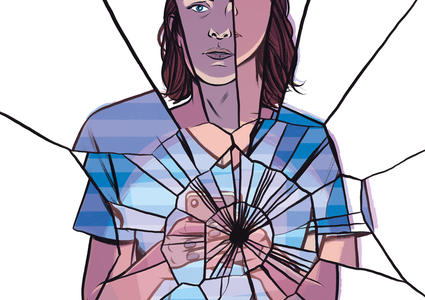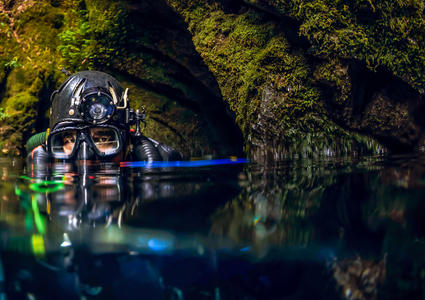Ultrasensitive nanomaterials for high-resolution, infrared cameras.
What do photo cameras and photovoltaic panels have in common? Until now, only light, essential for them to operate. But from now on, some micro crystals called quantum dots that allow both devices to be more efficient and less expensive.
The manufacturing and management of these nanocrystals is the specialty of Gerasimos Knostantatos, leader of the research group working on nanophotonic solution-processed devices at the Institute of Photonic Sciences (ICFO). This young electrical engineer and computer scientist has found a way of using them to create high performance photodetectors and image sensors at a much lower cost than that of current technology. “An infrared camera that costs $20,000 could be replaced by a cheaper one based on quantum dots, available for $100”, explains Konstantatos.
The high price of cameras that are able to capture light, not exclusively from the visible spectrum but also from the infrared, is due in part to the complex manufacturing of its sensors. The silicon, a key component in most chips and photodiodes found in cheap camera’s pixels, captures only between 20 and 40 percent of the light that comes into contact. Moreover, it is not sensitive to the infrared, which means that for night vision applications other semiconductors are needed, expensive alternatives based on indium gallium arsenide. As Konstantatos explains, the manufacturing of sensors with these materials is “complex and expensive” and the cameras that use them offer low resolutions -less than one megapixel.
On the contrary, by modifying the size and form of the quantum dots that he manufactures, Konstantatos takes advantage of the better photon absorption qualities of these nanocrystals to create photodetectors able to capture 100 percent of the light that arrives to them. While conventional sensors dedicate one part of its surface to light detection and another to accommodate electronic components needed to process the image, the designs by the young TR35 winner include a thin layer of quantum dots on top of the electronic part, which leads to “total area coverage”, superior sensitivity and resolutions of various megapixels.
This price-reducing method opens the door towards expanding the market of infrared cameras both for massive consumption and for night vision devices that could improve driving or security. In fact, infrared waves are also basic in fields like medical imaging, environmental monitoring, or deep space observation in astrophysics, areas that could benefit from the commercial development of these nanomaterials.
Furthermore, the transition towards its massive production could be simple now that Konstantatos has not only discovered the way of modulating quantum dot properties, but has also developed conventional processing systems to obtain them. “We use techniques similar to those that are used to manufacture CDs or DVDs”, explains the researcher. “We place one drop of solution where the quantum dots float in a substratum and we spin it until it extends, the solvent evaporates, and a thin layer is created in a solid state that covers the device”.
Based on Konstantatos’ inventions, his coworkers from the University of Toronto have founded the firm InVisage to market this technology in the digital imaging field. “They focus on cellphone cameras”, explains the innovator.
Konstantatos has also found a way to combine the advantages of quantum dots with those of other great promise in nanoscale science: graphene. The results of this combination, recently published in the scientific journal Nature Nanotechnology, explains how this configuration has obtained a “photoconductive gain without precedents”, and delves into a field of interest between material science and electrical engineering.
In 2005, the young researcher presented some polymers for solar cells able to capture wavelengths that conventional panels did not take advantage of. “We used quantum dots to increase its sensitivity and to capture infrared light”, he explains. Since then, photovoltaic technology has evolved immensely and his team barely uses polymers now; instead, they are using these nanomaterials directly. “We use quantum dots not only for absorption but also to transfer charges inside the solar panels”, he states. With this system they obtain efficiencies up to six percent, still far from traditional solar panel efficiencies that, however, are more expensive to manufacture. Konstantatos calculates that if they were to reach efficiencies up to 10 percent, what they hope to obtain in five years, they will be “in a better position than those of silicon in terms of cost per watt.”
The TR35 winner has demonstrated that it is possible to specify the materials’ promises -whose properties scientists do not entirely control right now-, but have created great expectations, for example, between those who dream of obtaining faster communication methods. “The beauty of these materials is that they can be deposited in silicon and you can integrate electrical and photonic circuits at a very low price”, he explains. According to Konstantatos, the transportation of information between chips is “the bottleneck of electronics” and using light to execute the transference, instead of an electronic base, would solve it. “But it is something that we foresee in the long term”, he points out.
At the moment, Juan Meléndez, professor at the Teledetection and Infrared Image Sensors Lab at Carlos III University of Madrid (Spain), believes Konstantatos's work is now “clearly innovative, both the technology that has been used and the results that have been obtained, in a field that has far-reaching applications”. In addition, Arturo Menchaca, group leader of the Experimental Physics Department at UNAM's Physics Institute (Mexico) and member of the TR35 Spain Awards’ jury, points out that at only 33 years of age, Konstantatos is already “a world-known scientist and technologist” by the advances he has published and co-authored, and that the technologies he develops promise to have “practical impact and significant potential to change our lives”. - Translated by Alfredo Corral


